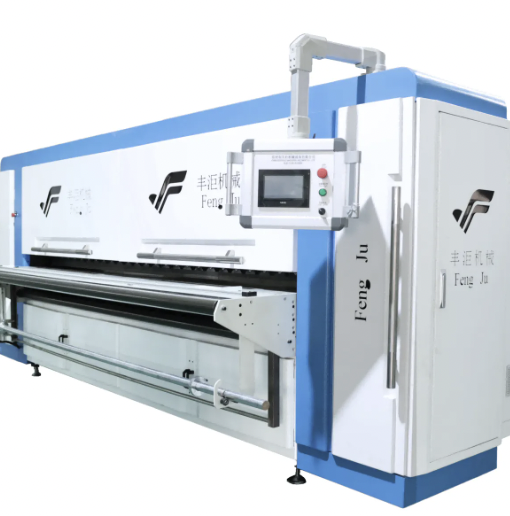紙プリーティング機による自動化された労務費削減
手作業の折り込みを排除:自動化が労働力要件をいかに削減するか
従来、紙を折る作業には人的資源が多く必要で、非熟練労働者による単調な仕事が相当な割合を占めており効率的ではありませんでした。しかし自動紙加工機の導入により状況は一変しました。工場に機械を導入することで企業は労働者数を削減でき、採用および教育訓練コストを節約することが可能です。例えば、工程を簡素化して事業運営能力を高める自動化された機械をご覧ください。業界レポートによると、ロボットシステムによってある産業分野では最大30%もの労働力削減が可能とされています。このような自動化により効率性が向上し、運用コストの削減を通じて競争力のある価格設定が可能になります。
人材を高付加価値生産業務へ再配備
紙のヒダ折りプロセスの自動化に主に使用されますが、このプロセスが自動化されれば、多くの労働者や熟練した専門家はより複雑な作業に集中できるようになり、結果として企業の生産性を大幅に向上させます。繰り返しの業務から解放された従業員は、より創造的かつ戦略的な役割を担うことができ、職務満足度や士気も高まります。XYZ Corpなどの組織では、自動化を導入し、新たに空いた人材を他のより価値ある仕事に活用することで大きな成功を収めています。このような戦略的な再編成は、人的資源を効果的に活用するだけでなく、従業員がビジネスの成長に大きく貢献するプロジェクトに自ら関与できるようにすることも促進します。
24/7製造運転における賃金支出への影響
機械によるプリーツ加工紙の生産は、特に24時間体制の製造環境において大幅な人件費削減が可能です。企業は自動化により従業員数を減らすことで、残業代や労働者に伴う福利厚生費のコストを抑えることができます。これらの逆回転機械は、常に人的監視が必要となる費用面での負担をかけずに繰り返し生産を行うことが可能です。複数の製造成功事例に基づき、企業は機械導入後25%のコスト削減を報告しています。給与支出を抑えると同時に生産量を増やすことができることから、24時間運用における自動化を取り入れるメリットは大きく、企業を差別化し価格競争力を維持する助けとなります。
大量生産のための高速生産
サイクル時間比較:手作業によるプリーツ加工 vs 機械操作
特に自動化を通じた折り紙の歴史は、生産サイクル時間に大きな影響を与えてきました。かつては手作業によるひだ加工が非常に労力と時間を要し、速度の遅さゆえに各製品あたりに異常に長い時間がかかっていました。しかし機械を使用することでサイクルタイムを大幅に短縮し、生産能力を増幅させることができます。例えば、紙産業研究協会の調査によると、自動機械は手作業よりも紙をヒダ状に折る工程において40倍も速いです。このような効率性の向上は、機械作業が提供する競争優位性および技術革新が紙の折り畳みプロセスにおけるスピードと迅速性を実現する上でいかに重要であるかを物語っています。
高容量紙製品製造におけるスケーラビリティの利点
プレーティング工程は、大量生産の紙製造において自動化するためにスケーラブルに設計することも可能です。このようなシステムにより、需要増加への迅速な対応が可能となり、依然としてPCC品質を維持することができます。メーカーは生産能力を最大限に引き出しながら製品品質を維持するために、このような柔軟性を必要としています。最近の予測によると、プレーティング工程における自動化の導入により生産能力を最大で300%まで高めることができ、世界中での紙消費量の増加傾向と一致しています。したがって、自動化されたソリューションは製造プロセスの大規模化を支援するだけでなく、より集約された生産量の中でも品質を保証します。
ケーススタディ:機械導入前後の生産能力利用率
より詳細な例として、プリーツ加工機の導入が設備利用率に与える大きな影響を紹介する。中規模の製紙会社では、自動化を導入する前は利用率が65%であったが、コンピュータ化後、その利用率は90%まで上昇し、生産性が大幅に向上した。このような進化は、統計データを用いても明らかにされるように、プリーツ加工の自動化による経済的な利益を示している。これらの結果は、製紙プロセスにおける設備利用率を技術革新がいかに変化させるかという重要性を改めて強調している。
精密設計による材料廃棄の最小化
紙加工プリーツ機作業における許容誤差の管理
紙のプレーティングにおいては、切断および折り加工を正確に行うために、公差管理が重要な要素となります。高精度な公差管理により、紙プレーティング機械は生産中のずれや誤差を低減し、材料の廃棄量を抑えることができます。生産ロットに関わらず狭い公差での加工も容易に達成でき、不良品の発生量を削減します。『A Journal of Manufacturing Processes』の報告によると、精密設計プロセスにより製造工程における廃材を最大20%まで削減できることが示されており、製造プロセスにおける精密技術の重要性が強調されています。この素材の節約はコスト効率向上にもつながり、紙業界の持続可能な政策にも合致しています。
自動品質保証システムによるエラー率の削減
自動化された品質管理システムにより、エラー削減と生産効率の大幅な向上が実現されます。リアルタイム監視と高度なセンサー技術を活用することで、生産プロセスの早い段階で欠陥を検出することが可能となり、無駄を削減し、一貫した品質を確保できます。このようなシステムを導入することで、誤り率を劇的に低減することが可能です。例えば、あるトラック輸送会社では自動化システムを導入した結果、誤り率を15%も削減しました。高度な品質監視により、品質基準は確実に維持され、不良品による廃棄物の削減も大きく進みました。
業界別不良率統計
高い不良率。業界固有の不良率は、多くの場合、手作業による工程に起因し、これが大きなロスを生じさせます。自動化装置には顕著な利点があり、不良発生頻度が低くなります。この一例として、紙工業協会(Paper Industrial Association)では、自動化導入後に不良率が8%から3%未満まで低下したと報告しています。これらの結果は、さまざまな業種における材料廃棄削減という観点で、自動化が閾値効果をもたらすことを示しています。正確な機械を活用することにより、企業の運転効率が改善されるだけでなく、環境持続可能性にも貢献することができ、これは自動化と不良率との関係性を考える上で最も重要な概念です。
現代プリーツ加工システムにおける省エネルギー運用
消費電力メトリクス:従来機 vs 高度機
伝統的な紙のプレーティングと比較して、現代の機械が使用するエネルギーに差があるという知識は、より効率的にエネルギーを使用したいと考えている製造業者にとって重要です。利用可能な技術の進歩により、現代のプレート加工機は、従来の機械よりも省エネかつ効率的に動作することが可能です。例えば、より高度な機械にはアイドル状態にある際に電力の無駄を抑える自動化機能が搭載されています。業界で公表された研究によると、高効率プレーティングシステムへの切り替えにより最大40%のエネルギー削減が可能であり、これにより継続的なコスト削減が実現されます。これらの機械は時間とエネルギーの消費が少なく、操作も迅速かつ正確です。
省エネマシン導入のROI分析
省エネルギー機械に関する財務調査では、エネルギー費用の削減と高い運転効率により、投資利益率(ROI)が非常に有利であることが示されています。償却計画は製造業者が予想されるエネルギー節約量に基づいて算出できます。例えば、高効率の機械モデルを導入すれば、数年以内に電気料金の削減を通じて投資回収が可能になります。DS Smithはこれらの設備改良の一部を実施した企業の一つであり、現在、長期にわたる豊かな財務的リターンを得ています。新時代のフォールディングマシンに資本を投下することで、企業はコスト削減とより良い収益性の基盤を獲得するだけでなく、環境保護にも貢献できます。
製紙プロセスにおける持続可能な製造トレンド
環境汚染や技術の進歩により、エコフレンドリーな処理は製紙業界でますます人気になっています。環境に優しい機械は持続可能性において大きな要因であり、紙をプレス加工する際に伴う炭素排出量の削減に貢献しています。「今日では、ほぼ60%の工場が重要な変化を遂げており、33%がすでに持続可能な方法へと移行し、水使用量の削減または維持という測定基準を採用しています。さらに25%の工場が、エネルギー消費量を抑えることでより顕著に持続可能な状態を実現しています。とはいえ、自動化技術や低エネルギー消費型システムにおける進歩のおかげで、紙パルプ工場はこれまで以上に容易にグリーン基準を満たせるようになっています。このようにして、エネルギー効率の高いシステムを業界プロセスに統合していくことにより、製紙業界はますます環境に配慮した未来へと近づいています。
運転の最適化を通じた収益性の向上
単位当たりコストの再配分モデル
紙加工業界において、単位当たりコストを削減するうえでの鍵は運転の最適化にある。いくつかの合理化と現代技術の支援により、需要の減少が利益率の低下を意味する必要はない。リーン生産やジャストインタイム方式など、いくつかの再配分計画がこの業界で活用可能である。例えば、国際紙業(International Paper)は、生産コストを削減し収益性を向上させるために運転を慎重に計画することにより、低コストオペレーターとしての地位を確立した。これらは、過酷な競争環境において戦略的な運転計画がかつてないほど重要であることを示すほんの一例である。
柔軟な生産能力による市場対応性の向上
自動化された生産機能は、需要の迅速な変更が可能になるため、企業の市場対応性を大幅に向上させます。柔軟な生産能力により、企業は市場の変化に迅速に対応し、顧客サービスを効率的に行うことが可能です。このような柔軟性は、業界によって需要が予測不能となる場合に特に重要です。例えば、ジョージア・パシフィック社は自動化を活用して市場機動性を高め、消費者および市場の変化に迅速に対応できるようになっています。このような即応性は、需要に即座に対応するだけでなく、市場での競争優位を獲得することにも貢献します。

減価償却スケジュールを含む長期的な財務計画
紙ひだ機械の減価償却計画は、機械設備の長期的な財務計画において重要です。企業は数週間分の作業以上の先見性を持つ必要を感じています。減価償却計画は、一定期間における機械設備の財務的影響を評価し、効率的な予算編成および将来予測を支援する点で重要です。財務アナリストは、減価償却を財務計画に組み込むことで、リソースをより効率的に活用し、より合理的な事業計画を策定できると一致して述べています。機械設備の有用寿命に基づいた減価償却スケジュールの設定や、財務の柔軟性を維持しながら将来の支出を費用対効果高く計画することが、優れた産業界の実践例として知られています。
よくある質問
自動紙ひだ機械を使用することの主な利点は何ですか?
自動紙ひだ加工機には、労働コストの削減、高付加価値業務への人的リソースの再配備、賃金費用の低減、生産スピードの加速、材料廃棄の最小化、エネルギー効率の高い運用、利益率の向上などの利点があります。
自動化された機械は紙製品の品質にどのような影響を与えますか?
自動化された機械は紙ひだ加工における精度を確保し、誤りを減少させることで、材料廃棄を最小限に抑えながら一貫した生産品質を実現します。
自動化は製紙業界における持続可能性に寄与できますか?
はい、自動化はエネルギー消費および材料廃棄の削減を通じて、製紙業界におけるエコフレンドリー性を高めることで持続可能性を促進します。

